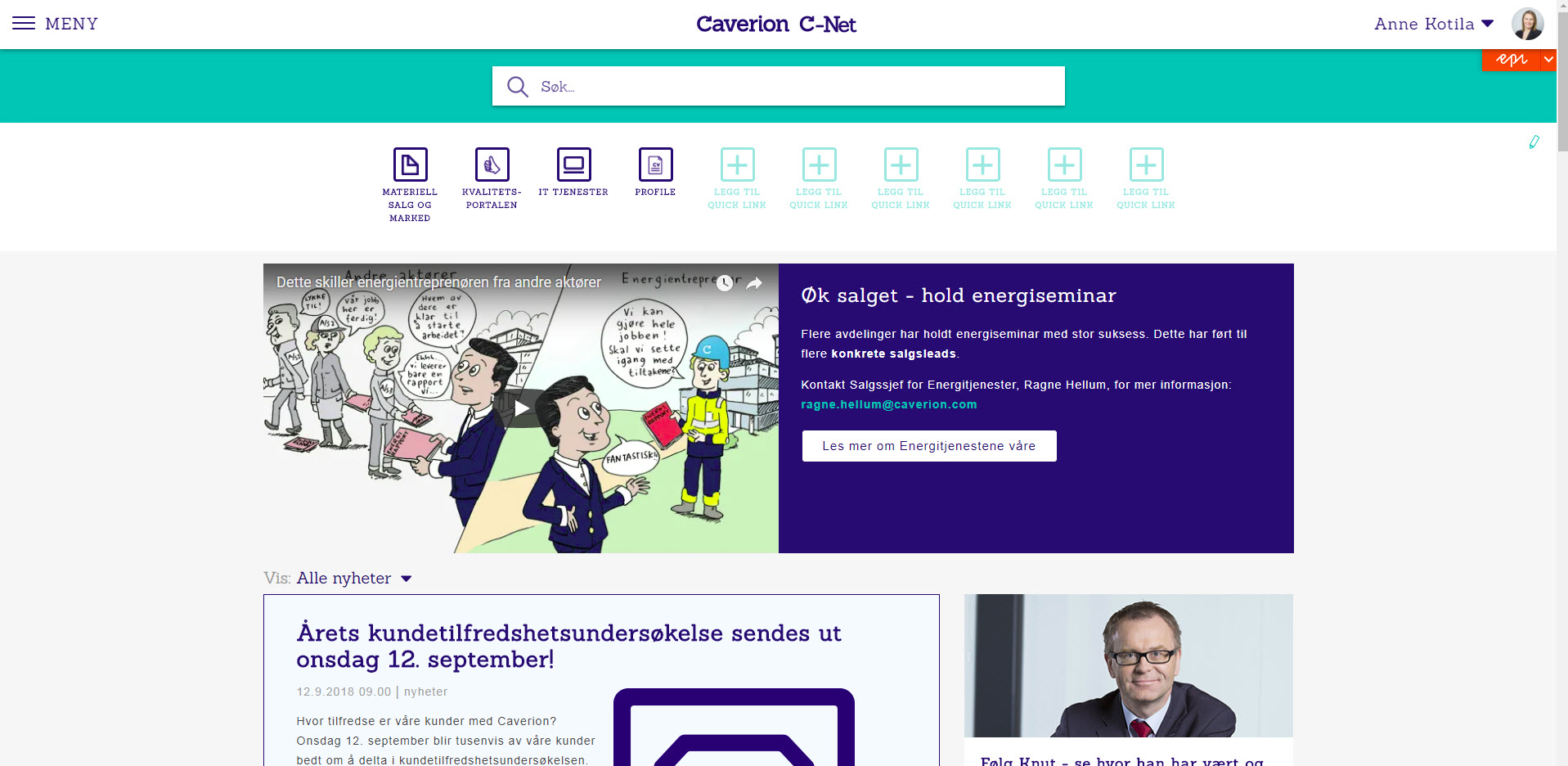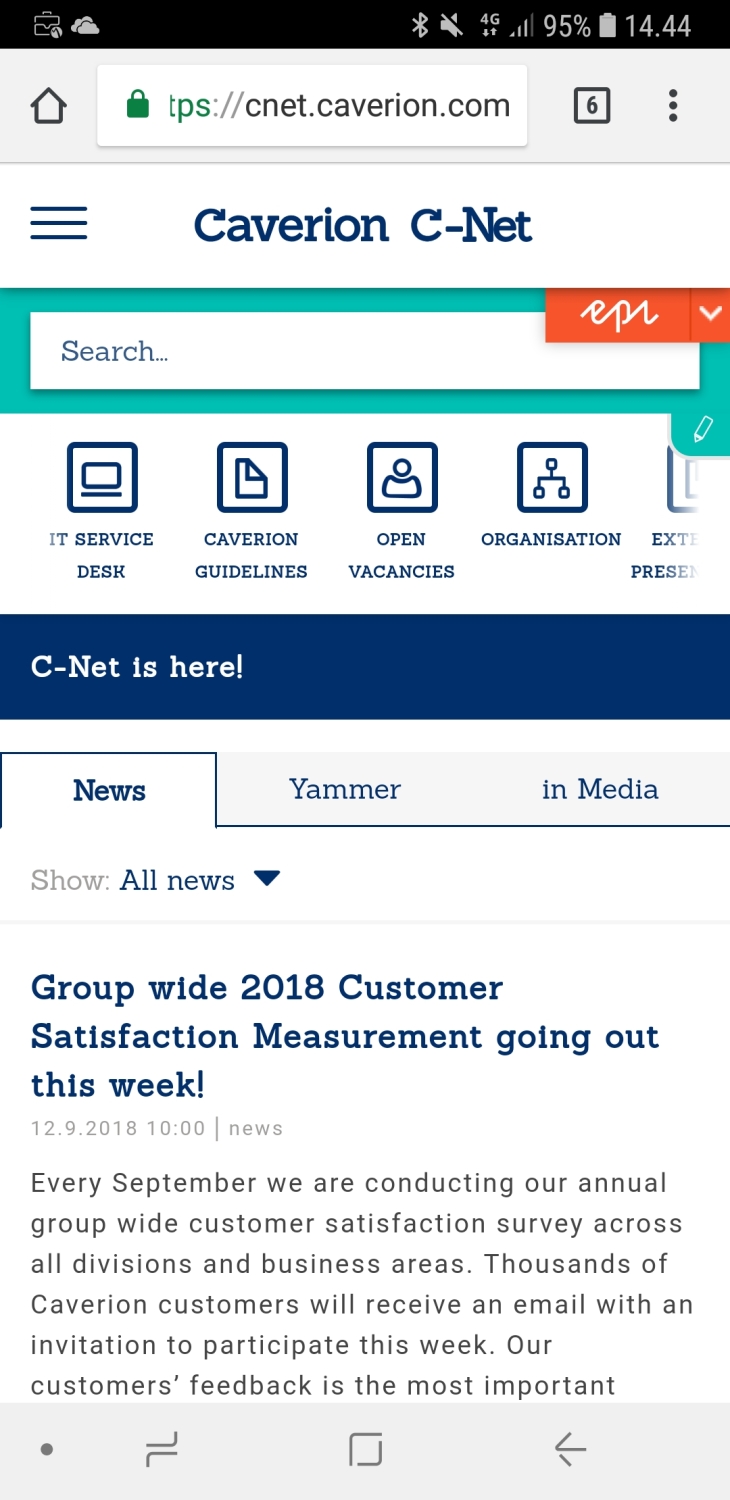Caverion designs, produces and maintains technical solutions in real estate and manufacturing. Their renewed intranet was launched in March 2018. The renewal sought to create a tool that would support daily work and enable concurrent communication throughout the organisation, regardless of language version or job title. The renewal and changes in content production were introduced on time and within the budget, thanks to strong ownership and leadership in the project. Here is what Anne Kotila, Digital Communications Manager, who was in charge of the project, and Päivi Alakuijala, Chief of Communication and Marketing at Caverion, have to say about the successful renewal.
North Patrol is a consulting firm specialized in the design of digital services and information systems. We shape ideas into a vision and service concept, find the best architectural and technological solutions, design a functional user experience, and compete to find the ideal partner for implementation work. We do not sell implementation projects, nor do we sell licenses; we are genuinely on the side of the customer.

– Our previous intranet had been scrambled together after Caverion spun off from YIT in 2013. It was being used only in some of our markets and had two different versions. Despite our well-functioning network of Communication Managers, we were struggling to ensure the communication of the company’s objectives, focus areas and practical information to all personnel groups and to all our operations in various countries because the technology did not support the process, Kotila says.
Caverion designs, produces, services and maintains user-friendly and energy-efficient technical solutions for the real estate, manufacturing and infrastructure sectors in Northern, Central and Eastern Europe. Caverion employs approximately 16,000 people in 12 countries, the majority of whom work outside the office.
– The old intranet was incapable of reaching this target group because the system had not been designed with their needs in mind and it could not be accessed from all the different terminal devices.
Preliminary survey and objectives
With the experience of Hanna P. Korhonen, Perttu Tolvanen and Kimmo Parkkinen, Caverion was able to map out their users’ and company’s needs, engage people in the planning, conceptualise the renewal, choose an appropriate technology, create early prototypes, determine requirements and find the right partner for the project.
For the planning phase, Caverion assigned to the project an active core group of three people from communications and IT, a project group of over 10 people, and an extended project group that included communication managers from various countries in addition to other participants. The extended project group engaged the personnel in all countries with co-design methods, such as interviews, testing and requesting comments on prototypes. The feedback was summarised, and project guidelines were determined at the project group workshops.
Based on the results of the preliminary survey, the following goals for the intranet renewal were determined:
- Mobile first. Access to the intranet for all personnel groups in all the countries which the company operates in.
- Focus on people. Support for networking and information sharing.
- One Caverion. Facilitating the company’s cultural evolution. Making the personnel increasingly proud about working at Caverion. Communicating success and accomplishment.
- Committed personnel. Communicating continuity through news regarding new partnerships, contracts and projects. Career opportunities and employee benefits.
- Supporting daily tasks. Contact directory and quick links to applications.
- Content largely localised. Harmonised content and communicating messages unchanged to the entire personnel with minimum manual labour.
Implementation
Anne Kotila served as the project manager over the implementation phase, staying in touch with the technology vendor and content producers.
The technical implementation on the Episerver platform was carried out by Solita. The project was managed in two-week sprints. Solita also created the appearance and user interface, which were designed to cater to both desktop and mobile users’ needs with the best features for each.
Communication managers and the people responsible for each group function were in key roles in content production. The most intensive phase in content production took place in November.
First, the English master structure was created in the system, forming the basis for the localised sites. Content that is common to all the countries is located in one place.
Creating a consistent content structure was absolutely critical for achieving the goals of the new intranet. The content structure was designed in cooperation with the company’s local organisations and functions.
Producing the content was a big undertaking, and in order to make it easier, the task was divided into smaller tasks. Each business function was responsible for their respective section of the intranet, and approximately three hundred employees across the functions participated in content creation.
– The work went surprisingly effortlessly. I think the fact that some of the people creating the content had also participated in the preliminary survey really helped with the dedication to the work. They were the same employees who had been outlining the objectives and methods of the new intranet, Kotila says.
The new intranet
Caverion’s new intranet supports a uniform culture and enables effective communication to everyone without bottlenecks.
The Episerver platform features unparalleled language support. In the new system, the Group communication department is able to add an urgent announcement (in English), and it is published simultaneously on each country organisation’s site. The communication managers of the country organisations may then translate the announcement to their respective language or choose to leave it in English. Information reaches every intranet user’s home page instantly and efficiently.
Quick links play a major role in the new intranet. The main user of each country organisation maintains a list of quick links and each intranet user may customise their view by choosing the links that are the most relevant to them. The links can be accessed from every page except the search results page.
The intranet also includes a contact directory as part of the content search function. For each contact profile, the contact details, supervisor and team members are retrieved automatically from background systems. Employees are able to complete their profiles with their photograph and information about their skills and knowledge.
Alongside the communicational intranet, Caverion uses Yammer, whence conversations are fed onto the intranet front page. According to Kotila, Yammer has been adopted with varying results in different countries. In Norway, for instance, support for new Yammer users has been generous and several active Yammer groups have been established.
Anne’s and Päivi’s tips for a successful intranet renewal:
- A thorough preliminary survey and conceptual planning lay out a solid foundation for the renewal
- Engage as many people as possible and ensure that the functions of the organisation feel that they are accountable for the content
- Keep all the stakeholder groups updated on the progress of the project
- Support from the senior management is important for the content producers in order to prioritise the project in their schedule
- Prepare a realistic schedule and stick to it. If the publishing needs to be rescheduled, do so as late as possible.
- Celebrate the publication! Give thanks to and acknowledge all the participants.
Case: Caverion’s intranet C-Net
Client: Caverion
Service: Communicational intranet covering all 12 country organisations
Platform: Episerver
Preliminary survey, conceptual design: North Patrol (spring and summer 2016)
Requirements specification and call for tenders: North Patrol (spring 2017)
Technical, visual and user interface design and implementation: Solita (autumn 2017)
Launch: March 2018
Original article (In Finnish) was written by Hanna Korhonen from North Patrol



